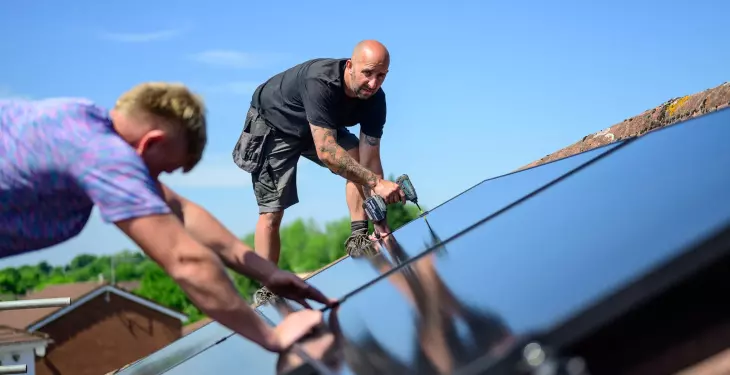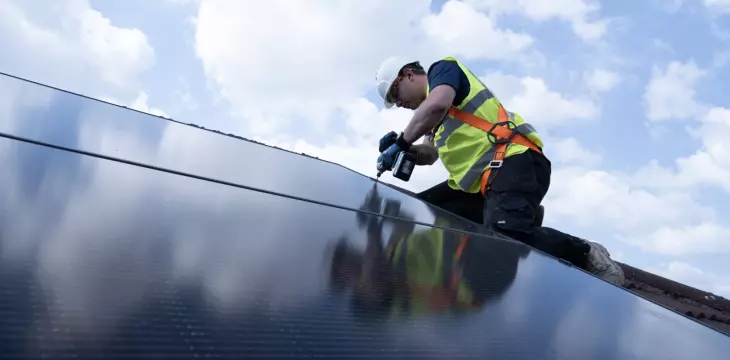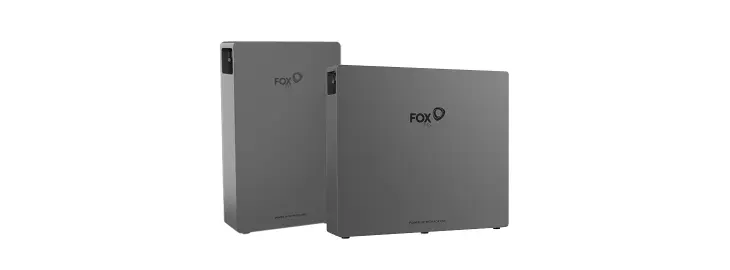

Written by Bethany Armstrong
Renewables Manager
Updated: 20th October, 2025
Solar panels can still generate electricity in winter, but their efficiency may be reduced due to shorter days and lower temperatures. Our guide explores the factors that affect solar panel performance in winter and provides practical tips to optimise their output.
See how much you could save with a solar & battery quote.
Solar panels are a popular choice for harnessing renewable energy and reducing one's dependence on fossil fuels. As people increasingly invest in solar energy technology, a common question arises: "Do solar panels work in winter?" This query puts emphasis on the seasonal impact on solar panels' ability to produce energy during cold months when sunlight might be scarce.
The short answer is yes, solar panels work in winter. While it's true that energy production may be somewhat reduced during colder months marked by shorter days, lower sun angles, and potentially more inclement weather, solar panels can still generate electricity.
The key factor at play is the presence of light, not heat. In layman's terms, solar panels operate based on daylight rather than sunlight.
Solar panels, composed of multiple photovoltaic cells, capture and convert sunlight into electrical energy. Crafted from silicon, these cells have properties that allow them to generate an electric current when struck by photons. This occurs as photons knock electrons free from atoms within the solar cells, initiating the flow of electricity.
Despite being renowned for their sunny-day performance, solar panels can still function on overcast days and during winter months. Though production levels do reduce in these conditions, they continue to harness the sun's energy.
Understandably, shorter daylight hours, lower sun angles, and cloud coverage contribute to decreased energy output, but the panels still deliver a noteworthy percentage of their total capacity.
Investing in solar panels accumulates numerous benefits, both environmentally and financially.
Households across the UK, for example, save approximately £520 per year on their energy bills and generate a profit exceeding £5,000 over the panel's lifetime. Moreover, solar energy contributes to a reduced carbon footprint, providing a sustainable and cleaner alternative to fossil fuels.
In conclusion, solar panels thrive in various weather conditions, including winter. They remain a highly valuable investment for homeowners, offering energy savings and playing a significant role in promoting green energy solutions.
The effectiveness of solar panels varies with different seasons due to several factors, such as sunlight exposure, daylight hours, and weather conditions. During the summer months, solar panels receive more sunlight and longer hours of daylight, which leads to higher energy production.
However, the question arises whether solar panels can generate as much electricity during the winter months.
In winter, sunlight becomes less intense, and the days are shorter, reducing the hours of daylight.
Despite these changes, solar panels continue to function and generate electricity as they operate primarily on daylight, not sunlight or heat. The efficiency might be slightly affected, but the panels will still produce electricity throughout the winter months.
Temperature is another factor that can influence solar energy. Contrary to popular belief, colder temperatures could actually improve solar panel efficiency.
Solar panels, being made of materials like silicon, perform better in colder environments, where heat-induced performance issues are minimised.
Weather conditions also play a significant role in the performance of solar panels. For instance, on cloudy or rainy days, less sunlight reaches the panels, which inevitably reduces energy output.
However, even under such circumstances, solar panels still manage to harness the diffused light and convert it into usable electricity.
During winter, some individuals may wonder whether solar panels are still capable of generating electricity. The answer is yes - solar panels continue to work even in cold and gloomy weather conditions.
However, their performance may vary depending on several factors, such as snow, ice, shading, overcast days, and cloud cover.
In the winter months, the days are shorter, resulting in fewer hours of daylight. Additionally, the sun's position in the sky is lower, leading to decreased solar energy production. Despite these challenges, solar panels remain functional, as they operate on sunlight, which is still available even on cloudy days.
Weather conditions like snow and ice can potentially disrupt solar panel efficiency. When a panel becomes covered in a layer of snow or ice, sunlight penetration becomes limited. Thus, it's essential to clear any snow or ice buildup from solar panels to maintain their performance.
To help with this, solar panels are often installed at steeper angles in regions prone to heavy snowfall, as this facilitates natural snow shedding.
Overcast days and cloud cover can also impact solar panel performance. Although sunlight can still penetrate through clouds, it is often diffused, which could result in decreased energy generation.
Despite this, solar panels are designed to handle varying light levels, ensuring they generate some electricity even on the gloomiest days.
During winter months, it's natural to wonder about the impact of cold temperatures on solar panels' performance. Interestingly, solar panels tend to be more efficient in lower temperatures.
In fact, higher temperatures can cause solar panels to lose efficiency due to increased resistance in their electrical components. The cold reduces this resistance, enhancing their performance.
However, the shortened daylight hours during the winter season lead to less solar energy production overall. This factor plays a key role in contrasting the heightened efficiency due to low temperatures.
Furthermore, the sun's lower position in the sky causes the panels to receive sunlight at a less optimal angle. Although this affects electricity generation, modern solar panel systems are designed to function effectively even with such conditions.
Solar panels can be affected by increased weight on their surfaces. In snowy regions, snow may accumulate on solar panels, causing additional weight and potentially decreasing their operational efficiency. Therefore, it is essential to keep solar panels clear of excess snow to ensure unobstructed access to sunlight.
During winter, many people wonder whether solar panels can still produce sufficient energy. The truth is, solar panels continue to generate electricity in winter, albeit at a slightly reduced rate compared to summer. Solar panels operate based on light, specifically daylight, rather than heat or direct sunlight. As a result, they can function efficiently even on cloudy or rainy days.
In colder temperatures, solar panel output can actually improve. This is because solar panels are more efficient at lower temperatures, meaning that they experience less loss in efficiency due to heat. The presence of snow can also contribute positively to solar energy production, as its white surface can reflect light onto the panels, thereby increasing their performance.
That said, the amount of daylight hours is typically reduced in winter, which leads to shorter periods of maximum output for solar panels. However, most regions still receive an adequate amount of sunlight to make solar energy production worthwhile during this time. The key factor determining solar panel efficiency is ensuring that they remain clear of snow. Snow-covered panels will experience a significant drop in energy production.
When discussing the performance of solar panels in winter, it is essential to consider their efficiency on cloudy days. Solar panels rely on sunlight to generate electricity, and the presence of clouds can affect the amount of light reaching the panels. However, this doesn't mean that solar panels cease to function on overcast days.
Although solar panels are more effective in direct sunlight, they can still produce electricity on cloudy days. In fact, light waves penetrate through clouds, enabling solar panels to generate energy even when the sky is not clear. Of course, the amount of electricity produced during cloudy or overcast days is usually less than on sunny days, but it is still possible.
Different factors, such as cloud thickness and the type of solar panel installed, can impact the amount of energy generated on cloudy days. For instance, some solar panels are designed to be more efficient in low-light conditions, allowing them to better harness diffused light. This can be beneficial in countries with a predominantly overcast climate, such as the UK.
Solar panels harness the power of sunlight to generate electricity. Direct sunlight is crucial for maximising this power generation, as panels operate at their highest efficiency and capacity under such conditions. Moreover, sunlight is more intense during sunny days, so solar panels can produce more electricity than on cloudy or snowy days.
Interestingly, solar panels don't rely on heat to generate electricity but rather on the sun's light. As a result, even in winter when the temperature drops and the weather is predominantly chilly, solar panels can still effectively function. The key factor remains the availability of direct sunlight during those colder months.
However, it should be noted that while solar panels can still work in winter, their efficiency may be affected by the shorter daylight hours and lower angle of the sun. For this reason, solar panels are typically installed at a specific angle to optimise the intake of the sun's UV rays, which helps to maximise electricity generation throughout the year, including winter.
Snow accumulation on solar panels can obstruct direct sunlight, thereby reducing their effectiveness. Fortunately, the angled design of most solar panels allows snow to slide off, minimising buildup. Additionally, larger frames installed around the solar panels can aid in preventing excessive snow accumulation.
Solar panels continue to function during winter, albeit with reduced performance due to shorter daylight hours and overcast weather. Despite these challenges, solar panels can still generate electricity and lead to energy savings on your energy bills throughout the year.
In the UK, the average homeowner who invests in solar panels may save around £520 per year on energy bills. This is primarily due to the fact that solar panels can produce approximately 85% of their maximum power output when averaged out across the year. Of course, energy savings can vary depending on factors such as location, panel orientation, and size of the installation.
The Energy Savings Trust reports that a standard 3-bedroom house utilises around 3,000 kWh of electricity annually. With a solar panel system in place, homeowners can offset a significant portion of their energy costs, even during the winter months. It is worth noting that cloud cover can decrease output by around 50%, whereas snow can cause an 80% reduction. However, well-maintained solar panels should bounce back in performance as weather conditions improve.
Although efficiency may drop between 50% and 90% during winter, solar panels remain a valuable long-term investment. Over the course of their lifetime, solar panels have the potential to generate a profit of more than £5,000 for homeowners. Furthermore, harnessing solar power helps reduce reliance on fossil fuels, contributing to environmental sustainability and helping fight climate change.
Investing in a solar panel system can be a wise decision for those looking to reduce their carbon footprint and save on energy costs. Solar panels harness the power of sunlight to generate electricity from renewable sources, which can be used to power homes and businesses. Installing a solar system allows individuals and companies to take advantage of the numerous benefits of renewable electricity.
One aspect to consider when investing in solar panels is their performance during the winter months. Although solar panels are more efficient in direct sunlight, they still work in winter, provided there is available light. Even on cloudy days, as long as photons reach the solar cells, electricity generation is possible. Solar panels continue to generate power throughout the year, albeit at a reduced capacity during winter months.
An essential component of a solar panel system is the solar battery. This energy storage device allows users to store excess electricity generated by their solar panels instead of sending it back to the grid. By incorporating batteries into their solar system, homeowners and businesses can further reduce their reliance on conventional energy sources.
Battery technology plays a crucial role in advancing renewable energy adoption. High-capacity energy storage solutions, such as lithium-ion batteries, promote increased efficiency and reduced costs. As batteries become more affordable, investing in a solar panel system with energy storage becomes an enticing prospect for those interested in generating renewable electricity.
Solar PV panels and solar batteries play different roles in the realm of renewable energy. While solar PV systems convert sunlight into electricity, solar batteries store the excess energy generated for later use. Both components can contribute to the efficiency of solar power production, even in colder months.
Solar PV panels perform well in winter, even if the sunlight is weaker due to shorter days and overcast conditions. They rely on light, not heat, to generate electricity. Although solar panel output reduces by an average of 83% during winter compared to summer, they continue to produce electricity as long as they receive direct or indirect sunlight.
On the other hand, solar battery systems serve as a vital energy storage component in solar energy systems. During winter, when solar PV panels generate less electricity, solar batteries come into play as an energy reserve. They store surplus electricity generated by solar PV panels during the day, enhancing the system's reliability and enabling continuous power supply for homes and businesses.
Integrating solar batteries into a solar PV system can optimise the overall efficiency, especially during winter. To make the most of this combination, homeowners should consider tilting their solar panels at a steep angle in winter to maximise electricity generation, while also utilising a high-capacity solar battery to store any excess energy. This way, they can leverage stored energy when the solar panels produce less electricity due to limited daylight or overcast conditions.
Solar panel installation is a vital step in harnessing the power of the sun to generate electricity for your home or business. A well-executed installation process ensures that the solar panels work efficiently, even during winter months. But how do you ensure a successful solar installation?
Firstly, it's essential to choose reputable solar installers with a proven track record. A skilled and experienced installer will accurately assess your property, taking into account factors such as your location, roof angle, and shading. This is crucial in determining the best setup to maximise your solar panel's performance.
Once you have selected the right installer, a thorough consultation will usually follow. During this phase, you will discuss specific requirements and customisation options. It is the perfect time to inquire about warranties provided by the installer and manufacturers in case of any future issue.
The installation process itself involves securing the solar panels on your roof or ground-mounted setup. Solar installers will then connect the panels to an inverter that will convert the sunlight-generated direct current (DC) power into alternating current (AC) power suitable for domestic use. This process is precise and efficient, ensuring that your solar panels are ready to operate.
In summary, solar panel installation is an intricate process that calls for meticulous care and seasoned solar installers to achieve optimal results. With the right knowledge, expertise, and equipment, your solar system can produce renewable energy even during the colder winter months, when sunlight hours are few and far between. Remember, the key to maximising your investment lies in selecting a capable solar installation team and securing a reliable warranty.
During winter, solar panels may face challenges due to snowfall and ice accumulation. Snow-covered panels result in obstructed sunlight absorption, causing a significant decline in efficiency. However, solar panels do still generate electricity in such conditions, albeit less than during summer months.
To ensure optimal energy production, it is important to keep snow and ice off solar panels. There are several methods available for homeowners to deal with these challenges, enabling panels to function effectively even in harsh winter weather.
Firstly, one popular method is to install panels at an angle that facilitates natural snow removal. When panels are slanted at an optimal angle, snow will simply slide off. This reduces manual removal efforts and allows for increased sunlight exposure.
Furthermore, using a roof rake to remove snow can be a useful strategy. Roof rakes with soft bristle edges or foam rollers can effectively clear accumulated snow without damaging the panels. While this method does require some physical effort, it can be highly effective when done properly.
Heating cables can also be installed on solar panels to melt snow and ice. These cables work by emitting a small amount of heat, effectively melting the snow and preventing ice from forming. However, additional energy expenditure should be considered when deciding on this option.
Taking proactive measures, such as regular panel maintenance and monitoring weather forecasts, can help homeowners prepare their solar panels for snowy conditions in advance. Thorough cleaning of solar panels before winter sets in might significantly enhance their performance by reducing the chance of snow and ice becoming a major obstacle.
Solar panels work in winter, albeit with reduced efficiency due to the decrease in available daylight hours. Even so, solar panel owners must maintain a connection to the National Grid to ensure a consistent energy supply. The National Grid plays an essential role in providing electricity to homes and businesses when solar power generation is insufficient.
The Smart Export Guarantee (SEG) is a scheme that benefits solar panel owners connected to the National Grid. Under this initiative, energy suppliers with over 150,000 customers are required to offer an export tariff for the excess energy generated by solar panels. This enables solar panel owners to receive payments for surplus electricity they return to the grid.
While solar panels can still generate electricity during winter months, the energy production is often insufficient to meet the household's power demands. This is where the National Grid connection becomes indispensable. During periods of low solar output, the grid ensures a steady and continuous supply of electricity, reducing the need for owners to rely exclusively on their solar panels for power.
As solar panel technology continues to advance, their efficiency during winter months is predicted to improve. Nevertheless, the National Grid remains a vital component of the solar energy system. By integrating solar panels with grid connections and participating in the Smart Export Guarantee, homeowners can efficiently utilise solar energy while maintaining a secure and stable power supply.
Solar panels are capable of harnessing energy from the sun even during winter months. Although days are shorter, and sunlight may not be as intense, solar panels can still generate electricity in these conditions.
One of the primary reasons solar panels continue to function in winter is that they rely on light, not heat. In fact, cooler temperatures can even improve solar panel efficiency, as excessive heat may lead to a decrease in performance. It is important to note, however, that the generated electricity during winter may be lower compared to summer months due to reduced daylight hours and the sun's position in the sky.
The energy harnessed by solar panels during winter can still be employed to power household appliances such as dishwashers or to provide electricity for other uses. Utilising solar power in this manner enables homeowners to reduce their dependence on traditional energy sources, potentially lowering energy bills.
Although solar panels tend to produce less energy in winter, they can still contribute significantly to a home's electricity requirements when properly installed and maintained. To maximise solar panel efficiency during winter, it is essential to ensure that the panels are free of snow and debris, as accumulated matter can obstruct sunlight and reduce the panels' ability to generate electricity.
Integrating solar panels with a new boiler can lead to several advantages for homeowners. First and foremost, solar panel costs have significantly decreased in recent years, making them more feasible for homeowners and businesses alike.
By harnessing solar power, households can experience a reduction in their energy bills whilst also benefiting the environment through sustainable heating.
Last updated: 20th October, 2025

Written by Bethany Armstrong
Renewables Manager at iHeat
Bethany Armstrong is a renewables expert and operations manager at iHeat, specialising in heat pump solutions and solar project delivery across the UK.
LinkedInArticles by Bethany Armstrong are reviewed by iHeat’s technical team to ensure accuracy and reliability.

19th November, 2025
Most UK homes take one to two days for solar panel installation, with the full process fro...
 Read Article
Read Article

14th November, 2025
In this guide we compare key panel types and specs for UK homes, outline typical installed...
 Read Article
Read Article

14th November, 2025
Your ideal solar battery size depends on your energy use and solar setup. This guide cover...
 Read Article
Read Article
No obligation. Takes less than 60 seconds.